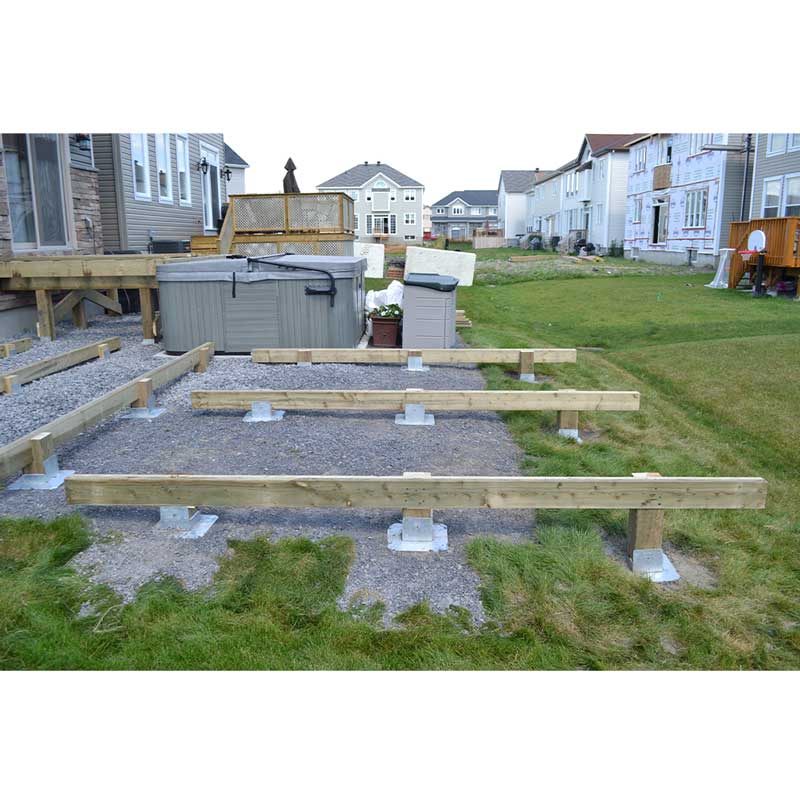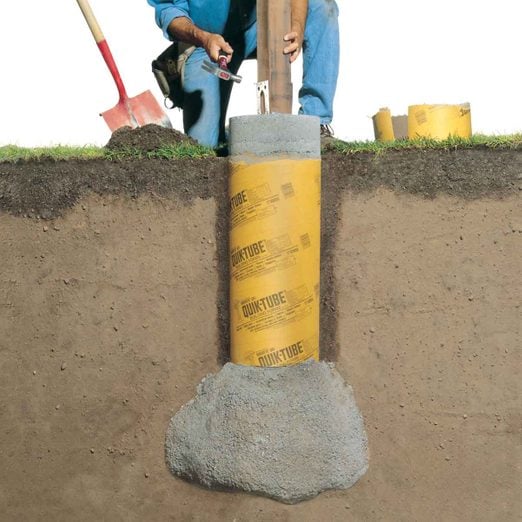Structure from the Ground Up: The Ultimate Overview to Creating and Installing Deck Footings
Wiki Article
Professional Tips for Installing Deck Footings to Assistance Your Outdoor Area
When it comes to building a deck, one of the most vital components to take into consideration is the installment of correct grounds. These grounds are the foundation upon which your outside area will rest, offering stability and support for years to come. What exactly does it take to install deck footings properly?Value of Appropriate Deck Grounds
Proper deck footings are important for making certain the stability and longevity of your outdoor room. Without strong and effectively set up footings, your deck may end up being unstable, leading to safety dangers and costly fixings.
In addition to security, correct deck footings also add to the long life of your outside space (Deck Footings). Grounds that are created and built to endure the elements and dirt problems in your area will certainly help stop the deck from settling or changing in time. By guaranteeing the grounds are appropriately sized and installed, you can reduce the danger of damage to the deck framework, extending its lifespan and lowering the demand for costly repair work or substitutes

Picking the Right Kind Of Footings
When picking the appropriate sort of grounds for your deck, it is essential to consider elements such as soil conditions, local building ordinance, and the overall layout of your outside area. The type of footing you choose will certainly play a vital function in guaranteeing the security and long life of your deck.One typical kind of ground is the concrete ground. Concrete grounds are suitable for a lot of dirt problems and provide excellent assistance for decks. They are typically installed listed below the frost line to stop shifting and clearing up because of freezing and thawing cycles. Another choice is helical piers, which are perfect for locations with unsteady soil or high water tables. These piers are screwed right into the ground and offer strong assistance for the deck.
In some cases, you might require to use specialized grounds, such as stack grounds or deep structures, if you are constructing a multi-level or big deck. These grounds are developed to disperse the weight of the deck over a larger area, guaranteeing security and avoiding working out or sinking.
Before picking a kind of footing, it is necessary to consult local building ordinance and guidelines to guarantee conformity. Additionally, take into consideration the layout and intended usage of your exterior area. Factors such as the size, form, and load-bearing demands of your deck will affect the kind of footing that is most suitable.
Preparing the Ground for Footing Installment
To correctly prepare the ground for footing installment, it is necessary to examine the soil problems and take required steps to guarantee stability and resilience of the deck. The initial step is to excavate the area where the grounds will certainly be mounted. The depth of the excavation will depend upon the frost line in your area and the certain needs of the deck design. It is necessary to eliminate any kind of vegetation, rocks, or debris from the excavation to guarantee a strong foundation.Once the area has actually been excavated, the next action is to portable the soil. This can be done making use of a plate compactor or by utilizing a hand meddle. Compacting the dirt aids to remove any kind of voids or air pockets, which can bring about settling and instability with time.
After condensing the dirt, it is necessary to lay a layer of gravel or smashed stone at the end of the excavation. This will certainly give water drainage and aid to stop water from pooling around the grounds, which can result in erosion and instability.
Step-by-Step Guide to Putting Up Deck Footings
After effectively preparing the ground for footing installment, the following action is to begin the procedure of mounting deck grounds. This detailed guide will certainly offer you with a clear understanding of exactly how to set up deck grounds for your outdoor space.Determine the location: Beginning by noting the settings of the deck grounds utilizing risks and string. Make certain that the areas line up with the design and design of your deck.
Dig the holes: Use an article hole miner or an auger to dig the openings for the footings. The depth and size of the openings should be in conformity with regional structure codes and the certain requirements of your deck style.
Degree the holes: Make use of a degree to make sure that the openings are dug to the appropriate deepness and are degree with each you could try these out various other. (Deck Footings)
Include gravel: Location a layer of crushed rock at the bottom of each opening to boost drainage and prevent the timber from decomposing.
Put the grounds: Put the grounds into the holes, ensuring they are level and plumb. Utilize a level page and a measuring tape to make certain precision.
Secure the grounds: Put concrete right into the holes around the footings, filling them to the top. Utilize a message degree to make sure the grounds remain level as the concrete collections.
Allow time for treating: Allow the concrete remedy according to the manufacturer's instructions before proceeding with the deck construction.
Usual Blunders to Avoid During Footing Setup
One important facet to consider during the installation of deck grounds is preventing usual mistakes that can compromise the security and longevity of your outdoor area. While deck grounds might appear like a simple and uncomplicated part of the building and construction process, forgeting specific aspects can lead to expensive repair work and prospective safety and security hazards down the line.
Additionally, overlooking to install correct drain measures can trigger water to collect around the grounds, resulting in rot, degeneration, and the ultimate weakening of the deck's structure. Additionally, using the wrong sort of footing material or stopping working to adequately protect the footings can compromise their structural integrity.
To avoid these mistakes, it is vital to seek advice from a specialist or comply with market guidelines to make certain correct footing installment. By doing so, you can guarantee the stability and long life of your exterior area, providing a delightful and safe environment for several years ahead.
Final Thought
To next page conclude, installing proper deck grounds is crucial for the stability and longevity of your outdoor area. By choosing the right kind of footings and properly preparing the ground, you can guarantee a strong foundation for your deck. Following a step-by-step overview and staying clear of typical mistakes throughout footing setup will certainly additionally enhance the toughness and safety of your deck.Correct deck grounds are crucial for guaranteeing the security and durability of your exterior area. The footings serve as a connection between the deck and the ground, permitting the weight of the deck and its residents to be distributed uniformly into the soil.One usual kind of footing is the concrete footing. Insert the footings: Put the grounds into the openings, making sure they are level and plumb. Protect the footings: Put concrete right into the holes around the grounds, loading them to the top.
Report this wiki page